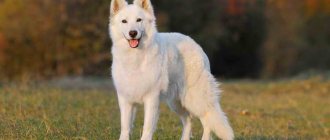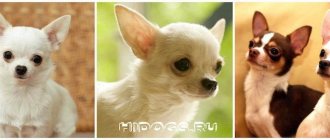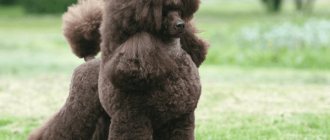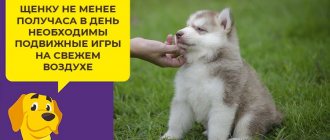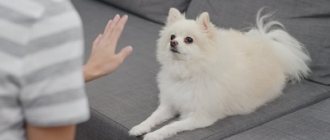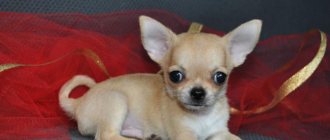The Mexican Hairless Dog is a rare breed. For the first time, such puppies were bred in the temples of Mexico as an animal for cult. The second name of the Xoloitzcuintle breed is derived from the name of the pagan god Xolotl, and “Itzcuintli” is interpreted as “dog” or “slave”. A characteristic feature of the breed is the absence of premolars (molars) and the presence of sweat glands on the body (and not just on the tongue and limbs, like other dogs). Their friendly nature makes naked Mexicans excellent companions.
Origin story
Xolos are included in the Guinness Book of Records as the oldest and warmest mammals on Earth. Statues depicting dogs of the hairless Mexican breed were found during excavations of Indian burials in Central America. The ancient Indians believed that bald Xolos escorted the dead to the world of spirits.
It was the Aztecs who gave the breed the name Xoloitzcuintle.
The hairless dog's high body temperature made it a healer. The ancient Aztecs raised them for their delicious meat, which they prepared on major holidays. After the colonization of Mexico by the Spaniards, the breed was exterminated as part of a pagan cult. But some individuals survived, so the xolos have survived to this day. For several centuries, no one needed bald Mexicans, and the renewed interest in them is associated with the name of the Spanish artist Frida Kahlo and her husband. The American Kennel Club recognized the Mexican Hairless breed in 1887. In 1959, the Xolo was excluded due to its small numbers. And in 2008, the breeders managed to re-enter them into the register.
Olga Volkova about the Mexican hairless dog
If the name of this breed - Mexican Hairless Dog - seems too long to you, just call it Xoloitzcuintle (or if you are really familiar, then you can call it Xolo). God Xolotl is the patron of twins and ugly things, the guide of the souls of the dead on their journey to the afterlife. Well, Itzcuintli is just a “dog”, but in the Nahuatl language. The Xolotla dog is apparently the oldest of all existing breeds. Archaeological finds have confirmed that Xolos began to live next to people at least three thousand years ago, and millennia did not in any way affect the appearance of these dogs. They remained what they were. The only thing that has happened to the Xolo over the last hundred years is the division of the breed into three weight categories - mini, medium and large. In pre-Columbian America, all xolos were medium-sized, that is, they had a height of 40-50 centimeters. Well, then some of them, through the efforts of post-Columbian dog handlers, decreased and now do not even reach 35 cm, and the second part went up, sometimes outgrowing the 60-centimeter line. However, both the Pigalitsa weighing 3 kg and the quite large 30 kg dog are still the same Xolo, the temple dog of the Toltecs and Aztecs, which played a very important role in the life of the Indians.
Firstly, xolo helped the souls of the dead reach their destination. The Indians, who did not know high humanistic ideals, killed the dog and buried it with its owner. Secondly, on especially special occasions the Aztecs and Toltecs considered it necessary to eat a dog or two. Thirdly, the Indians slept together with the Xolo (in a good way) - on cold winter nights, a naked, warm dog warmed better than another grumpy wife. Fourthly, with the help of Xolo, the Indians were treated for all diseases and wounds. Fortunately, this time they didn’t eat the dog, but just snuggled closer to it. With all this, the Indians treated their xolos without much sentimentality. That is, no one thought of spending sleepless nights nursing weak puppies or treating sick dogs. On the one hand, this is very bad, but, on the other hand, such strictness led to the fact that for thousands of years only the strongest, healthiest and unpretentious xolos survived and gave birth to offspring. And now we have a dog that endures all adversity without problems, rarely gets sick, recovers quickly, lives a long time and is able to adapt to literally any conditions. Well, the fact that a hairless Xolo looks very vulnerable is not true. In fact, this naked creature does not need clothing even in 30-degree frost. No, the xolo cannot live outside, but a short walk in the cold does not threaten her with anything terrible.
It is unknown when and under what circumstances xolos lost their hair, but even three thousand years ago they were completely naked. Over the past millennia, Xolo skin has acquired very strange properties. For example, invulnerability. No, of course, these dogs also have injuries, but all wounds, bites, stitches and scratches heal not only quickly, but also without a trace - scars or keloid scars are unknown in Xolo. Moreover, they say that Xolos can also dissolve the scars of their beloved owners. The dog will simply lie down for a month or two next to the injured area - and not a trace will remain of the scar. It is also believed that Xolos can treat asthma, relieve owners from insomnia and stress, help with skin diseases, fight rheumatism, heal sore joints and spines, slow down cancer processes and remove negative energy. And Xolos also tan, and very noticeably - in a word, these dogs, especially light-skinned ones, should definitely be smeared with baby sunscreen in the summer. And it’s also better to wash the Xolo with baby soap, and then, to prevent the skin from drying out, it would be good to anoint the dog with baby body milk. Although, in general, washing the Xolo is completely optional. What is there to wash? Just wipe with a cloth.
An elegant, strong body, a narrow muzzle, high erect ears and a very complex character - that’s what the Xoloitzcuintle is. However, a complex character does not mean bad. It's just that Xolos are so smart that you shouldn't interact with them as if they were ordinary dogs. They hate stupid, meaningless commands, and they strongly disagree with people humiliating them. So, for some reason, one strange person put a full bowl of food in front of his Xolo and at the same time told the dog: “You can’t.” Xolo is obedient; she did not eat and suffered terribly, because these slender dogs are famous for their incredible appetite. So she obeyed and suffered for a week, a month, two - and then she began to take revenge. The peaceful dog began to growl terribly at his owner, began to make puddles everywhere to spite her, and clearly fell out of love with his man. In the end, they had to break up. And in the new home, where the xolo was surrounded with due respect, this dog behaved completely like an angel. In short, Xolos should be treated as equals. And you also need to love her - without love, the xolo withers and sadly pees on the owner’s pillow.
Xolo is also no stranger to some stubbornness. Thus, these dogs learn all sciences very easily, but they do this only for food and praise. But they don’t work for fear - if you spank a xolo, then out of spite for the one who hit you, they may stop listening to him altogether.
Xolos are also terrible owners. My toy, my bowl, my home, my owner - they are ready to fight for this, just like for their homeland. No, they, of course, will not bite the owner who encroaches on their property, but they will try to brush off other animals. And in general, they dream of driving away all outsiders from their territory. Xolos, especially the larger ones, really love to fight and do it very skillfully. However, this breed has one fairly common feature - the so-called lack of teeth (that is, the absence of fangs), which prevents the fighting Xolo from causing particularly serious damage to the enemy. Well, they themselves are so dexterous, fast and jumping that you can’t really bite them either. In addition, although Xolos are brave, they are also very careful and judicious. Before starting a fight, this dog must weigh everything, think it over and evaluate the situation. However, the Xolo will stand up for his beloved owner or his home without hesitation - if we are talking about a large variety of this dog. Little Xolos are well aware of their own limits; however, on occasion they will not deny themselves the pleasure of digging into the heel of the attacker.
Most often, xolos choose one favorite owner; however, they also treat the rest of the family quite favorably. But they go to bed only out of great love (and, as a rule, they choose exclusively adult family members for sleeping). And if you think that your Xolo will not be allowed under your blanket, then you are terribly mistaken. It seems that sleeping in a bed has become as much a genetic trait of Xolos over the past millennia as not having hair. Therefore, sooner or later, if you don’t wash it, your dog will end up under your blanket anyway. So relax and have fun - a person can only benefit from the presence of a Mexican hairless dog snuffling next to him.
In his free time from sleep, the xolo also strives to snuggle up to his loved one. If there is only one Mexican hairless dog in the house, then from morning to night it will try to attract its owner’s attention by kissing, climbing on knees, touching with its paw, looking into the eyes (xolos love to be talked to, and, listening to your speeches, touchingly raise their already high ears and wrinkle their bald forehead in a Socratic manner) and other dog things. If there is more than one xolo living in the house, then they will devote part of their time to fighting for human attention and for their place in the pack, which will free up some personal time for the owners and help the dog itself stay in good physical shape. The fact is that Xolos are the greatest gluttons of our time, and without movement they can turn into something indescribable. Fortunately, their fast metabolism allows them to lose weight without resorting to high-impact physical activity. That is, these dogs also need exercise, but they do not at all require their owners to run for many hours. Yes, they don’t demand anything from their owners at all - you just love them and treat them like rational beings, and everything will be fine with you.
Xolo puppies (about €2 thousand) are unusually exuberant and terribly funny creatures, similar to funny little hippos that are too big for their own skin. You can see Xoloitzcuintles of all ages, sizes and colors in all their glory on the website www.harmeks.ru.
Description of the breed
Xolos are one of the oldest indigenous varieties of dogs of natural origin. They evolved according to a harmonious pattern. Naked Mexicans are graceful and elegant, have speed and strength, but are never rude.
Dogs of this breed have a clear silhouette, a proportional body, a powerful chest and clearly defined ribs, long strong legs and a tail. There are two main varieties, differing in the presence (or absence) of fur and the structure of the teeth.
Xoloitzcuintle breed
If you want something exotic in your home, get a hairless Xoloitzcuintle dog. This breed is considered the oldest in the world, that is, in fact, your pet’s ancestors were one of the first representatives of canine families. This is one of the reasons to be proud of your pet with ancient history. The Xoloitzcuintle breed is also called the Mexican Hairless Dog. The fact is that this breed of dog actually came to us from Mexico. In their native land, the Xoloitzcuintle is a great asset and pride of their country.
Xoloitzcuintle builds
There are 3 configurations:
- Miniature dogs (weight from 2 to 7 kg, height from 25 cm to 35 cm);
- Medium dogs (weight from 7 to 14 kg, height from 36 cm to 45 cm);
- Standard dogs (weight from 11 to 18 kg, height from 46 cm to 60 cm).
a) miniature xoloitzcuintle; b) xoloitzcuintle standard
Many people love the Hairless Xoloitzcuintle dog for the warmth that comes from them. And all because most often this breed does not have hair. And when you touch such a dog, you feel the warmth of its body and the softness of its delicate skin. Xoloitzcuintles are also often called “hugging dogs.” Thanks to their warmth, no one can resist the temptation to hug such a dog. They even say that hugging a Xoloitzcuintle can relieve arthritis pain and improve your mood.
You might be interested in: The Pomeranian is a little miracle!
Differences between the breed and other dogs
Xoloitzcuintles differ from other breeds in their specific appearance. But, despite the fact that these dogs will not be to everyone’s taste due to their specific appearance, they still have a lot of features that would be the envy of any other breed.
a) xoloitzcuintle with wool; b) Xoloitzcuintle without hair
One of the features of this dog breed is its versatility. Representatives of the Xoloitzcuintle can not only be “bald”, but in some cases also have fur. Also, dogs of this breed sometimes differ in size from each other.
Features of the Xoloitzcuintle breed
- The main feature of the Xoloitzcuintle is their appearance; most often they are completely hairless dogs.
- This breed of dog is suitable for any type of home, thanks to its wide selection of sizes.
- The Xoloitzcuintle will not only be an excellent friend to its owner, but also a guard dog for the entire house.
- The absence of fur allows people to feel the dog’s inner warmth, so they constantly want to hug and stroke it. And who wouldn’t want to have a “cuddle dog” in their home?
- There are only about 30,000 Xoloitzcuintle dogs around the world, which is relatively small compared to other breeds.
- The Hairless Xoloitzcuintle dog is completely hypoallergenic due to its lack of fur.
- The Xoloitzcuintle has incredible hunter's sense and can easily pursue other animals or game, so it will be an excellent hunting companion.
- Such a dog can be dressed up in beautiful outfits, because due to the lack of fur, it can be cold in the fall and winter.
- The Xoloitzcuintle breed appeared naturally, which gives it special value.
- Since ancient times, it has been believed that Xoloitzcuintle dogs have special healing powers and can cure absolutely any disease. And even in our time, many people believe in their special power.
Characteristics and standards
The Mexican Hairless breed standard requires the dog to have a high forehead, a narrow jaw and a smeared poll. Flat cheeks turn into tightly compressed lips. Correct bite is required. Individuals without molars and even completely toothless ones are allowed to participate in the exhibition. But the latter are not allowed to reproduce. The Xolo has a powerful square nose, the color of the tip of which varies depending on the color (black for dark ones, beige or pink for light ones). Almond-shaped eyes with dense eyelids also differ in the color of the iris. The ears are large and erect.
Such dogs have an elongated body, a muscular long neck, a straight back and vaguely defined withers. Paws with strong muscles. The shade of the claws and toe pads corresponds to the color. The tail tapers towards the end, is raised during activity, and lowered at rest.
What to feed your Xoloitzcuintle
Mexican Hairless dogs are prone to food allergies and skin diseases. The best option for them is to eat a balanced ready-made food with a high protein content. Mixtures based on grains and feed with artificial colors are undesirable.
Representatives of the breed often suffer from dental problems . If an adult dog's teeth are falling out, it is better to feed it premium soft canned food. Some brands have varieties specifically designed for Mexican Hairless dogs and Chihuahuas.
To avoid skin and stomach problems, it is better not to give dogs treats from the table . For reward, use pieces of meat or freeze-dried ready-made food.
Purpose
Among the ancient Indians, the Mexican hairless dog guarded the house and treated illnesses. The Aztecs believed that it drew illness out of the owner, and then lay in a puddle, releasing him into the pit. If the disease did not respond to treatment, the dog died by refusing to eat or by drowning. The Aztecs grew xolos for food. Their meat was considered a delicacy and was consumed during pagan ceremonies.
Today, Mexican hairless dogs live as pets without any responsibilities. They participate in exhibitions and are used as companions for the disabled and lonely old people.
History of the origin of the Xoloitzcuintle
The Xoloitzcuintle (Mexican Hairless Dog) is one of the oldest breeds , bred more than 3,000 years ago. Mexico is considered the birthplace of the breed . Some experts believe that these dogs were the first companions of humans.
A randomly recorded mutation gave the animal an unusual appearance and reverence from the Indians. Dogs were considered sacred , they participated in the religious rituals of the ancient Aztecs and were often sacrificed. Some sources mention that the ancestors of modern Indians ate xoloitzcuintle meat.
Character and appearance
The Xolo's head is similar to that of a wolf with a smooth transition from nose to muzzle. The jaw is square, the lips are dry, the ears are erect, the chest is powerful and muscular. Puppies have folds on their necks that disappear with age. The back is straight, shortened. The tail is long, tapering towards the end. The paws are strong, straight, the toes are clenched, reminiscent of a hare. The hairless variety has short hairs on the tail, legs, neck and head. The second has a whole body covered with coarse short hair. The color of the Xolo is blue, red, fawn, bronze, graphite, gray or black.
Spots are acceptable, but preference is given to individuals of the same color.
The nature of the dogs is friendly. A hairless Mexican dog will become a good friend or a reliable protector. They are distrustful of strangers, but are always kind and affectionate towards their owners. Xolo is an active breed that needs daily communication with the owner and the warmth of his hands. They get along well with other pets and prefer sports and walks. This is not a “couch” dog, so the owner will have to share their active lifestyle.
Advantages and disadvantages
Advantages of keeping Xolo:
- balanced character;
- protective abilities: wariness of strangers, selflessness;
- neatness and cleanliness;
- good health;
- high activity;
- unpretentiousness in food.
Despite this, the Mexican Hairless Dog is not for everyone. The breed has a number of disadvantages:
- tendency to allergies, dermatological diseases, sunburn, caries;
- the individual requires special skin care;
- she must be trained;
- The dog behaves aggressively when meeting unfamiliar dogs.
Properly caring for your dog
Representatives of the Xoloitzcuintle breed require special care, because their delicate skin is exposed to many dangers. Since such dogs do not have hair protection, their skin can easily get burned, scratched or injured, etc.
a) trimming claws; b) washing paws
Even though Xoloitzcuintles most often lack hair on their bodies, they still need to be brushed. It is necessary to bathe and clean the skin of your pets, especially the paws and armpits, where the most dangerous microbes accumulate.
The Xoloitzcuintle's claws grow quite quickly, so it is worth trimming them in a timely manner. It is best to trim your pet's nails weekly to prevent this problem from causing you any inconvenience.
It is also worth remembering that all dogs have very sensitive teeth. This is due to their diet. Therefore, it is necessary to take care of your pet's teeth at least 2 or 3 times a week. Also, it is worth considering that not all dogs enjoy the process of brushing their teeth. Therefore, the sooner you start accustoming your Xoloitzcuintle to this procedure, the faster he will get used to it and stop resisting.
There is another enemy of the Xoloitzcuintle – allergies. Despite the fact that they are considered hypoallergenic dogs, they themselves often suffer from skin diseases and allergies. Most often, allergies occur to food.
Special hypoallergenic food is produced for the Xoloitzcuintle breed. But if you still cannot avoid allergies, then you will have to really fight the rashes and sores on your pet’s skin.
Nowadays, pet stores sell many different creams that will help you care for your Xoloitzcuintle's skin. And they will help your pet get rid of allergies, and simply make the skin softer and more delicate.
Varieties
The breed is classified according to two parameters - size and the presence of hair. According to the first sign, miniature (25-35 cm), medium (35-45 cm) and standard (45-60 cm) hairless Mexican dogs are distinguished.
According to the second there are:
- Hairless variety of dogs. Its main feature is the (almost complete) absence of hair on its delicate, smooth skin and molars. This is due to the “naked gene” of the animal.
- Wool look. These Xolos have a body covered with stiff, short hairs. The individuals have a fully formed dental system: all 42 teeth are present.
Maintenance and care
No special care is required for standard or mini specimens. It is important to provide your Mexican hairless dog with a place to rest and play, so that he has something to do while waiting for his owner. You should walk your pet 2 times a day, periodically taking it out into nature. This will give him the opportunity to run around to his heart's content.
The delicate skin of hairless Xolos requires special attention. It is recommended to bathe them once every six months. After water procedures, a softening oil is applied to protect the pet’s skin from irritation and drying out. The ears and eyes are systematically cleaned, and the claws are trimmed.
Expert opinion
Anna Abramenko
An avid dog lover. Experience in veterinary medicine since 2009.
Ask a Question
In winter and late autumn, walk your pet only in a warm sweater or overalls.
Education and training
Smart, intuitively understanding the mood of the owner, the hairless Mexican dog needs systematic physical and intellectual training. Xolo quickly gets used to its owner, needs daily communication, and its character directly depends on proper training. If a puppy is not introduced to animals and people at an early age, he will forever remain withdrawn and distrustful.
When raising, it is prohibited:
- use physical punishment;
- raise your voice.
This frightens the pet and it refuses to complete the task. The owner needs to be consistent in his demands, patiently repeat the command until the naked Mexican understands it. The best reward for a new skill is stroking or a treat.
Every dog tries to please its owner. That is why he must be discreet and sincerely love the pet. This is the key to a long and loyal friendship.
Training and education of the Xoloitzcuintle
Xoloitzcuintles are distinguished by their intelligence and good memory , so they quickly remember simple commands. You need to train a puppy from the first days of its arrival in the house. The dog must know its place, not bark for no reason, and come to the owner at the first call. Without proper training, an active and curious dog can become uncontrollable.
Excessive aggressiveness must be suppressed . Stop fights with other dogs; in a fight, Xoloitzcuintles can be seriously injured, leaving unsightly scars on their delicate skin.
Nutrition
The daily menu is compiled taking into account the Xolo's predisposition to allergic reactions. Abrupt changes in diet are prohibited. And new products are introduced gradually, monitoring health status. Not recommended:
- beef, chicken;
- fish, eggs;
- sweets, legumes;
- canned food, spices;
- baked goods, confectionery products.
To exclude allergies, give a small amount of the product. If there are no rashes or indigestion, increase the portion. Ideally, the diet of a hairless Mexican dog consists of one third of vegetables, cereals and dairy products, and two thirds of protein foods (turkey, rabbit, lean sea fish without bones).
Expert opinion
Anna Abramenko
An avid dog lover. Experience in veterinary medicine since 2009.
Ask a Question
After eating, your pet should be given time to rest. Otherwise, he may experience a volvulus.
Physical activity, proper nutrition and proper drinking regime are the key to good metabolism and health of a hairless dog.
Diseases and life expectancy
The ancient Aztecs believed that hairless Mexican dogs treated rheumatism, relieve attacks of pain, and normalize blood pressure (blood pressure). However, the description of the breed indicates a hereditary predisposition to certain diseases.
Hairless Xolos face dermatological problems, which can be avoided by proper care of the animal's skin. Pets are also prone to allergies to food and synthetics. Therefore, you should pay close attention to your dog’s diet and clothing. With proper care and nutrition, Xolos can live up to 15 years.
Maintenance and care of the Xoloitzcuintle
Mexican Hairless dogs are not overly demanding . They need a comfortable place to sleep and toys so that the pet can occupy itself in the absence of the owner. It is recommended to walk the dog twice a day; from time to time the pet needs to be taken out of town so that the dog can run properly .
Xoloitzcuintles require careful skin care . It is not recommended to wash the dog too often; bathing with animal shampoos is allowed once every 3-6 months. After washing, the skin should be treated with almond or soybean oil, which restores the hydrolipid balance.
Dogs need to regularly clean their eyes and ears and trim their nails. During the cold season, Xoloitzcuintles should walk in warm overalls or sweaters.
Choosing a puppy
When buying a pet, you need to give preference to the most active and inquisitive baby. If you want to participate in exhibitions, it is better to choose a naked variety of a single color. The cost of such a puppy is higher, but it is ideal for breeding.
Before purchasing, it is recommended to meet the parents of the little Xolo and evaluate the conditions of its maintenance. The health and appearance of a hairless Mexican dog largely depends on the responsibility of the breeder.
How to choose a Xoloitzcuintle puppy
Choose the strongest, most active and curious puppy from the litter. For those who are planning a pet's show career, it is better to purchase a puppy of a dark, uniform color, without hair. Such dogs are more expensive and are suitable for breeding.
The ideal puppy should have a lean, compact body, a narrow muzzle with large ears set high. Evaluate the mother of the puppies, read the pedigree of the parents. It is also important in what conditions the dogs are kept. A puppy from a responsible breeder will usually be in good health and conformation.
Reviews
Rita, Stavropol: “I saw a miniature hairless Xolo for the first time at an exhibition and immediately became a fan. I bought a puppy in the capital and took it by taxi. Our Jimmy instantly won the love of all family members. We choose our food very carefully, but for 3 years we have only gone to the vet for vaccinations.”
Nikolay, St. Petersburg: “I gave a naked Mexican to my wife on March 8th. She had long wanted a small pet dog. Very happy with the breed. Doesn't shed, doesn't smell like "dog", doesn't just bark. The dog quickly remembered all the commands. I recommend it for living in an apartment.”
Irina, Perm: “We bought a baby Xolo for our daughter’s birthday. The price is high, but the dog is also unique. The red puppy immediately became friends with the child, and now the two of them walk and play pranks. There is simply no better friend for a daughter than a Mexican Hairless dog.”
Owner reviews of the Xoloitzcuintle
Zhanna:
I saw a little Mexican dog at an exhibition and immediately fell in love. I was looking for a puppy for a long time, there are no breeders in our city. As a result, I brought my Shelly from Moscow. Now she is the favorite of the whole family: lively, cheerful, very beautiful. The breeder warned that there might be health problems, but Shelley has never been sick in three years; we only go to the veterinarian for vaccinations. We don’t go to exhibitions; we get our share of surprise and delight at the dog park.
Sergey:
A Mexican hairless dog recently appeared in the family, this is my gift to my wife. She dreamed of a devoted little dog that she could keep in her apartment. This breed was perfect. We chose a very beautiful dark brown puppy, it was not cheap. Food for him is also expensive, but there are no health problems. Everyone is completely happy with the dog; it’s especially great that she doesn’t shed and doesn’t smell like a dog. Yes, and obedient, understands commands, does not bark idlely. Good dog, I'm happy.
Share
Leave a review
Photo and video review
Photos of hairless dogs will help you decide on the color and appearance (hairless or hairless). And the specialist in the video will tell you in detail about the rules of maintenance, feeding and care. Will reveal the nuances of pets living in private homes.
The Mexican Xolo needs daily exercise, walks in the fresh air and communication with the owner. And if you follow all the rules, then over time you can get a devoted and best friend in the body of a dog.
